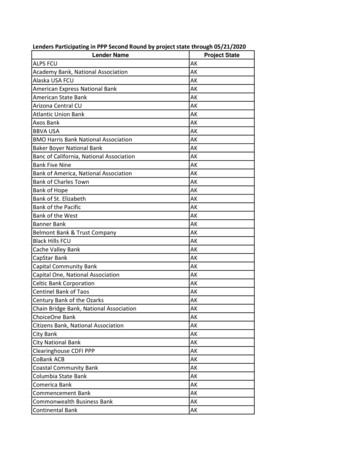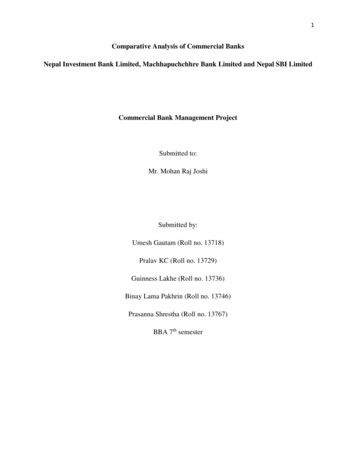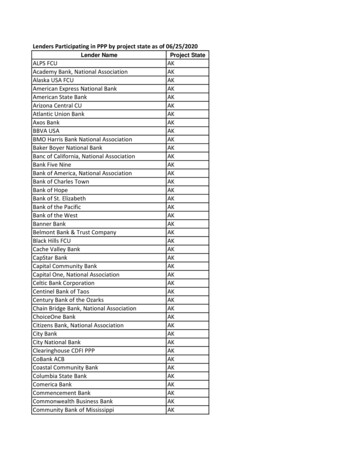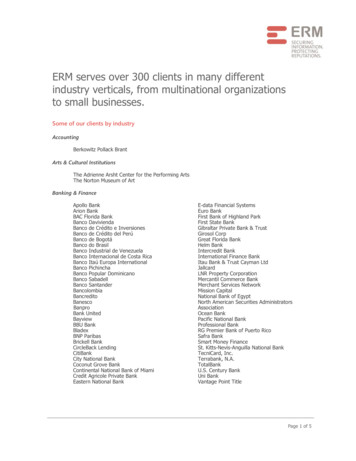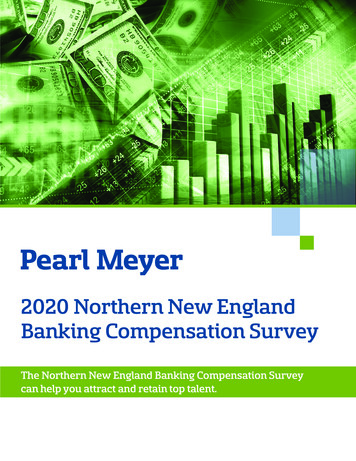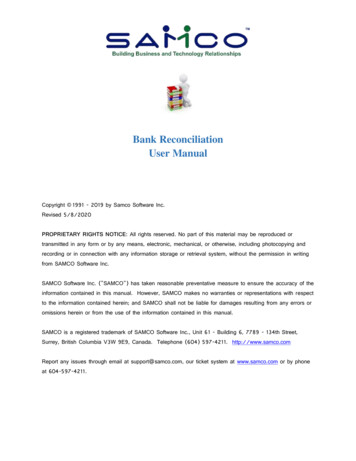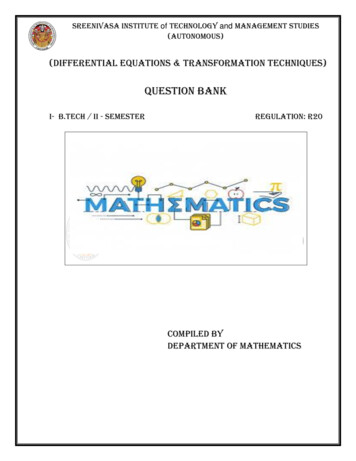
Transcription
SREENIVASA INSTITUTE of TECHNOLOGY and MANAGEMENT STUDIES(autonomous)(DIFFERENTIAL EQUATIONS & TRANSFORMATION TECHNIQUES)QUESTION BANKI- B.TECH / II - SEMESTERregulation: r20Compiled byDepartment OF MATHEMATICS
SREENIVASA INSTITUTE OF TECHNOLOGY AND MANAGEMENT STUDIES(Autonomous)DEPARTMENT of SCIENCE AND HUMANITIESQUESTION BANKDIFFERENTIAL EQUATIONS &TRANSFORM TECHNIQUES (20BSC121)QuestionNo.QuestionsBLOOMSTAXONOMYUNIT – 1:ORDINARY DIFFERENTIAL EQUATIONSPART-A (Two Marks Questions)Short Answer Type Questions1. Find the differential equation of y a x2, where a is a parameter2. Find the differential equation of 𝑥 2 𝑦 2 𝑎2 , where a is a parameter3. Write the solution of 𝑑𝑦 𝑃(𝑥 )𝑦 𝑄(𝑥)𝑑𝑥4. Write the solution of 𝑑𝑥 𝑃(𝑦)𝑥 𝑄(𝑦)𝑑𝑦5. Find the Integrating factor of𝑑𝑦6. Find the Integrating factor of𝑑𝑦L1L2,L3 𝑥𝑦 sin 𝑥7. Find the Integrating factor of (1-𝑥 2 ) 𝑑𝑦 𝑥𝑦 𝑎𝑥𝑑𝑥8. Find the Integrating factor of (x y 1)dy/dx 19.d2y 2 a y 0Solvedx 210. Solve𝑑2 𝑦 3 𝑑𝑦 2𝑦 0𝑑𝑥 2𝑑2 𝑦L1𝑦 𝑥 cos 𝑥𝑑𝑥𝑑𝑥L2,L3L2,L3𝑑𝑥𝑑𝑦11. Solve 6 𝑑𝑥 9𝑦 0𝑑𝑥 212.d 2 y dy y 0Solvedx 2 dx13. Find the general solution of (4D2 4D 1) y 0 .14. Solve ( D3 1) y 015. Solve ( D 1)2 ( D 2) y 016. Find the particular integral of (D2 6D 4)y e3x17. Solve ( D 1)2 ( D 2) y 018. Find the particular integral of ( D2 9) y cos3x19. Find the particular integral of (4D2 4D 1)y 10020. Write the formulae for A and B in method of variation of OOMSTAXONOMYUNIT – 1 ORDINARY DIFFERENTIAL EQUATIONSPART-B (Ten Marks Questions)1.dyysin 2 x a)Solvedx x log x log xb) Solve (1 y )dx (tan22.a) Solve( x 1) 1y x)dydy y e 3 x ( x 1) 2dxL2,L3L2,L3L2,L32
SREENIVASA INSTITUTE OF TECHNOLOGY AND MANAGEMENT STUDIES(Autonomous)DEPARTMENT of SCIENCE AND HUMANITIESQUESTION BANK3.4.5.DIFFERENTIAL EQUATIONS &TRANSFORM TECHNIQUES (20BSC121)3 dyb) Solve x 2 y ydxdy y x3 y 6Solve xdxdy x sin 2 y x3 cos 2 ySolvedxdy Tan y (1 x)e x sec ySolvedx 1 xL2,L3L2,L3L2,L3L2,L3d 3yd2ydy 9 23 15 y 032dxdxdx32d yd ydy 6 2 11 6 y e 2 x e 3 xb) Solve3dxdxdx2a) Solve D 4 D 4 y 18cosh xa) Solve6.7.8.9.b) Solve D 2 D 1 y sin 2 xL2,L3L2,L3L2,L3b) Solve ( D 3 1) y e x sin 3x 2L2,L3a) Solve (D 2 2D 3) y x 3L2,L3b) Solve d y 6 dy 13 y 8 e 3 x sin 2 x2 L2,L32 dx x10.Solve ( D 3D 2) y e11.Solve ( D 2 D D) y e13.L2,L3a) Solve D 2 4 D 3 y sin 3x cos 2 x dx12.L2,L3232Solve D 1 y x sin x x 2 cos x2x x 2 x sin 2 x2L2,L3L2,L3L2,L3Solve D 2 4 D 4 y 8 x 2e 2 x sin 2 xL2,L314.d2ySolve 2 4 y tan 2 x by the Method of variation of ParameterdxL2,L315.If voltage of a battery in an L-R circuit is 10 sin t, Find the current I in the circuit under theinitial condition I(0) 0.L2,L3QNo.QuestionsBloomsTaxonomyUNIT –2: PARTIAL DIFFERENTIAL EQUATIONSPART-A (Two Marks Questions)1.2.3.4.5.Define partial differential equation and give an example?Define order and degree of a partial differential equation?Give an example for first order and first-degree partial differential equation.Form the partial differential equation by eliminating the arbitrary constants a and bfrom z ax by a 2 b2Form the partial differential equation by eliminating the arbitrary constants a and bfrom 𝑧 𝑎𝑥𝑦 𝑏L1L1L1L2,L3L2,L33
SREENIVASA INSTITUTE OF TECHNOLOGY AND MANAGEMENT STUDIES(Autonomous)DEPARTMENT of SCIENCE AND HUMANITIESQUESTION RENTIAL EQUATIONS &TRANSFORM TECHNIQUES (20BSC121)Form the partial differential equation by eliminating the arbitrary constants a and bL2,L3from 𝑧 𝑎𝑥 2 𝑏𝑦 2Form the partial differential equation by eliminating the arbitrary constants a and bL2,L3from 𝑧 (𝑥 𝑎)(𝑦 𝑏)Form the partial differential equation by eliminating the arbitrary function fromL2,L3z f ( x2 y 2 )Form the partial differential equation by eliminating the arbitrary function from 𝑧 L2,L3𝜙(𝑦/𝑥)Form the partial differential equation by eliminating the arbitrary function fromL2,L3𝑧 𝑓(𝑥 𝑦)L1Define Linear partial differential equation with an exampleL1Define Non-linear partial differential equation with an exampleL2,L3Solve xp yq zL2,L3What are the multiplies to solve (y-z)p (z-x)q x-y by method of multipliesL2,L3Solve p q kSolve pq kSolve p2 q2 1L2,L3Solve z px qy (p3 q3)Solve z-px-qy pqL1What is the process in method of separation of variablesPART-B (Ten Marks Questions)a) Form the partial differential equation by eliminating the arbitrary constants a & b𝑥21.𝑦2from 2𝑧 𝑎2 𝑏2b) Form the partial differential equation by eliminating the arbitrary constants a & bfrom 𝑧 (𝑥 𝑎)2 (𝑦 𝑏)2a)Form the partial differential equation by eliminating the arbitrary constants h & k2.3.4.5.6.7.8.from ( x h)2 ( y k )2 z 2 a 2b)Form the partial differential equation by eliminating the arbitrary constants h & kfrom x2 y2 (z-c)2 r2Form the partial differential equation by eliminating the arbitrary constants a, b fromlog(𝑎𝑧 1) 𝑥 𝑎𝑦 𝑏Form the partial differential equation by eliminating the arbitrary constants a, b & cx2 y 2 z 2 1a 2 b2 c2Form the partial differential equation by eliminating the arbitrary function from𝑙𝑥 𝑚𝑦 𝑛𝑧 (𝑥 2 𝑦 2 𝑧 2 )Form the partial differential equation by eliminating the arbitrary functionz (𝑥 𝑦)𝑓(𝑥 2 𝑦 2 )Form the partial differential equation by eliminating the arbitrary function (𝑥 2 𝑦 2 𝑧 2 , 𝑧 2 2𝑥𝑦) 0Form the partial differential equation by eliminating the arbitrary functions f and 4
SREENIVASA INSTITUTE OF TECHNOLOGY AND MANAGEMENT STUDIES(Autonomous)DEPARTMENT of SCIENCE AND HUMANITIESQUESTION BANKDIFFERENTIAL EQUATIONS &TRANSFORM TECHNIQUES (20BSC121)from 𝑧 𝑓 (𝑥 𝑐𝑡) 𝑔(𝑥 𝑐𝑡)a) Solve yzp zxq xy9.b) Solve (y2 z/x)p zxq y2a) Solve (mz-ny)p (nx-lz)q ly-mx10.b) Solve x2(y-z)p y2(z-x)q z2(x-y)11. Solve z2(p2 q2 1) c212. Solve z2(p2 q2) x2 y213. Solve 𝑢 𝑥14. Solve15. 𝑢 2 𝑡 𝑢 and u( x,0) 6 e 3 xL2,L3L2,L3L2,L3L2,L3, by the method of separation of variables4u x u y 3u and u(0, y) e 5 y , by the method of separation of variablesSolve 𝑢𝑥 4𝑢𝑦 0 and 𝑢(0, 𝑦) 8 𝑒 3𝑦 , by the method of separation yQuestionsUNIT – 3: LAPLACE TRANSFORM18.PART-A (Two Marks Questions)Find 𝑖)𝐿(cos 4𝑡) 𝑖𝑖) 𝐿(𝑠𝑖ℎℎ 2𝑡) 𝑖𝑖𝑖)𝐿(𝑡 3 ) 𝑖𝑣)𝐿(cosh 5𝑡)Find 𝐿{ 𝑠𝑖𝑛2 2𝑡}Find 𝐿{𝑠𝑖𝑛2𝑡 𝑠𝑖𝑛3𝑡}Find 𝐿{𝑒 2𝑡 cos 3𝑡}Find 𝐿{𝑒 5𝑡 sinh 2𝑡}Find 𝐿{𝑡 2 𝑒 3𝑡 }State First shifting property of Laplace transformState Change of scale property of Laplace transformState multiplication by t property of Laplace transformState division by t property of Laplace transformState Laplace transform of second order derivateState Laplace transform of integralState second shifting property of Laplace trasnform2𝜋𝐶𝑜𝑠(𝑡 3 ) ; 𝑡 2𝜋/3If 𝑓(𝑡) {then find L{f(t)}0 ;𝑡 2𝜋/3Define Unit step function and derive Laplace Transform of Unit Step FunctionDefine Period function and Laplace transform of period functionDefine Unit impulse function and Laplace Transform of unit impulse function1}Find 𝐿 1 {19.Find20.State Convolution .𝑠(𝑠 1)1𝐿 1 {(𝑠 1)2}i) 1,L2L1L1L1L1,L2L1,L2L1PART-B (Ten Marks Questions) L e2t 4t 3 2 sin 3t 3 cos 3tii) Find the Laplace Transforms of a) cos 2.i) Evaluate L e 3t (2 cos 5t 3 sin 5t )3.i) If L F (t ) 9s 12s 15 , Find L F (3t ) ( s 1) 32L1,L22tb) cos 2t.cos 3tii) Find 𝐿[𝑠𝑖𝑛 𝑡 𝑠𝑖𝑛ℎ 𝑡]L1,L22L1,L25
SREENIVASA INSTITUTE OF TECHNOLOGY AND MANAGEMENT STUDIES(Autonomous)DEPARTMENT of SCIENCE AND HUMANITIESQUESTION BANKDIFFERENTIAL EQUATIONS &TRANSFORM TECHNIQUES (20BSC121) e sin t Ldt ii) Find t0 t4.5.6. tFind i) L {t2cos 3t}ii) L {t e-2tcos t}Find the Laplace Transform of cos 2t cos 3tL1,L2L1,L2tFind L F (t ) , where F (t ) is a periodic function of periodo t sin t ,F (t ) 0 t 2 7. s 2 2 s 6s 7 s ii) Find L-1 5 (s 6) 8.Find the Inverse Laplace Transform of9.Find the Inverse Laplace Transform of2 and it is given byL1,L2i) Find L-1 L1,L2Find the Inverse Laplace Transform of10.11.12.13.4( s 1)( s 2)L1,L2s2 s 2s( s 3)( s 2)L1,L25s 3 s 1 s 2 2s 5 L1,L2Using the Convolution Theorem find L 1 s22222 (s a )( s b ) Solve the differential equationL1,L2d 2xdx 4 12 x e3t given that x(0) 1 and x1(0) -22dtdtby using laplace transformUsing Laplace transform solve (D2 2D – 3)y sinx if y(0) y1(0) 0.214.Solve15.Solved xdx 3 2 x e t , Given that2dtdtx(0) 0 andx1 (0) 1y 3 y 2 y 4t e 3t , Given that y (0) 1 and y1 (0) ,L3BloomsTaxonomy12UNIT – 4: FOURIER SERIESPART-A (Two Marks Questions)Write the Fourier series expansion of f(x) in [0,2L]Write the Fourier series expansion of f ( x ) in (0, 2 )3456Write the Fourier series expansion of f ( x ) in ( 𝜋, 𝜋)Define periodic function.Define even and odd functions with suitable examplesWrite the Dirichlet’s conditions.7If f ( x) x x in ( , ) , then find the value of the Fourier coefficient a0 .L1,L28Find an in the expansion off ( x) x in ( , ) .L1,L22L1L1L1L1L1L16
SREENIVASA INSTITUTE OF TECHNOLOGY AND MANAGEMENT STUDIES(Autonomous)DEPARTMENT of SCIENCE AND HUMANITIESQUESTION BANKDIFFERENTIAL EQUATIONS &TRANSFORM TECHNIQUES (20BSC121) , x, x 0, then the find the value of a0 .0 x 9If f ( x) 10If f ( x ) is defined in 0 x 2 write the formulae for a0 , an and bn .Is f(x) x cos x is even or odd with explanationIs f(x) x- x2 is even or odd with explanationExpress f ( x ) x as a Fourier series in ( ,15Write the Half range sine series expansion of f ( x )16Find bn in the half range sine series for f ( x) 1 in (0,L11718Find an in the expansion of19Find a0 in the expansion of f ( x) sin x in (0,20If f ( x) , x,L1,L2L1,L2L1,L2L1,L2 ) ).Find a0 in the half range cosine series for f ( x) 1 in (0, ) .L1,L2L1,L2f ( x) x in ( , ) .L1,L2 ).L1,L2 x 0, then the find the value of a0 .0 x L1,L2PART-B (Ten Marks Questions)Find the Fourier series representing f ( x) x, 0 x 2 .Obtain the Fourier series for f ( x) x x in the interval22.L1,L2If f ( x ) is defined in x write the formulae for a0 , an and bn .111213141.L1,L2L1,L2 , . Hence show that1 1 1 1 2 . .12 22 32 4212L1,L2Obtain the Fourier series expansion of f ( x ) given that f ( x) ( x) in 0 x 2 and23.hence deduce the value of1 1 1 2 . .12 22 326L1,L2 , x 0and0 x x,Find the Fourier series of the periodic function defined as f ( x) 4.1 1 1 2hence deduce that 2 2 2 . .1 3 582Expand the function f ( x) x as a Fourier series in , and hence deduce thatL1,L26.1 1 1 1 2 . 12 22 32 42121 1 1 1 2(b) 2 2 2 2 . 1 2 3 46Find the Fourier expansion of f ( x) x cos x, 0 x 2 .7.Find the Fourier expansion of f ( x) e , (o, 2 )L1,L28.Find a half-range cosine series of f ( x) e , 0 x lL1,L29.Find a half-range cosine series of5.10.(a)L1,L2L1,L2xxf ( x) 1, 0 x 2Find a Fourier-series expansion for the function f(x) defined by 𝑓(𝑥) {L1,L21 2𝑥, 𝜋 𝑥 0𝜋2𝑥1 𝜋,0 𝑥 𝜋L1,L27
SREENIVASA INSTITUTE OF TECHNOLOGY AND MANAGEMENT STUDIES(Autonomous)DEPARTMENT of SCIENCE AND HUMANITIESQUESTION BANK11.12.13.14.DIFFERENTIAL EQUATIONS &TRANSFORM TECHNIQUES (20BSC121)0 x Find the half range sine series for the function f ( x ) x in the range 0 x Find the half range sine series for f ( x) x( x) in 0 x and deduce that1 1 1 1 3. . 13 33 53 73322Find the Fourier sine series of the function f ( x) x , 0 x 3Find the half range cosine for the function f ( x ) x in the rangeL1,L2L1,L2L1,L2L1,L2215.𝑥 ,0 𝑥 2Find the Fourier cosine series of the function 𝑓(𝑥) {4, 2 𝑥 4QuestionNo.L1,L2BloomsTaxonomyQuestionsUNIT – 5: FOURIER -A (Two Marks Questions)State Fourier integral theorem.Write the formulae for Fourier Sine integrals.Write the formulae for Fourier Cosine integralsWrite the formulae for Complex Fourier integralDefine Fourier transform.Define Fourier Sine transformDefine Fourier Cosine transformDefine inverse Fourier Sine transformDefine inverse Fourier Cosine transformState linear property of Fourier transforms.State shifting property of Fourier transforms.Define Finite Fourier cosine transformDefine Inverse finite Fourier cosine transformDefine finite Fourier sine transformDefine Inverse finite Fourier cosine transformPART-B (Ten Marks Questions)L1L1L1L1L1L1L1L1L1L1L1L1L1L1L1 1. sin x (e ax e bx )d ; a, b 0 0 ( 2 a2 )( 2 b2 )2(b2 a 2 )Using Fourier integral, show that 2.Using Fourier integral, show that 01 cos , 0 x sin x d 2 0, x L1,L2L1,L2 3. 2 2 cos x d e x cos xUsing Fourier integral, show that 4( 4)20Find the Fourier transform of4. (a)5. 1,f ( x) defined by f ( x) 0,sin p 0 p dpL1,L2x ax aand hence evaluateL1,L2 (b)sin ap cos pxdpp 1 x 2 , x 1Find the Fourier transform of f ( x ) defined by f ( x) x 1 0,and henceL1,L2evaluate8
SREENIVASA INSTITUTE OF TECHNOLOGY AND MANAGEMENT STUDIES(Autonomous)DEPARTMENT of SCIENCE AND HUMANITIESQUESTION BANKDIFFERENTIAL EQUATIONS &TRANSFORM TECHNIQUES (20BSC121) (a)x cos x sin xxcos dx3 0x2(b) 0x cos x sin xdxx36.𝑎 𝑥 , 𝑥 𝑎Show that Fourier transform of 𝑓(𝑥) { 𝑥 𝑎0,7.Find the Fourier transform of8.2is 𝑠2 [1 cos 𝑎𝑠] sin x, o x f ( x) defined by f ( x) otherwise 0, a 2 x 2 , x aFind the Fourier transform of f ( x) and hencex a 0, x cos x sin x dx 3 0x4 𝑠 sin 𝑥𝑠9.Find the Fourier sine transform of 𝑓(𝑥) 𝑒 𝑎𝑥 and deduce that 010.11.Find the Finite Fourier sine and cosine transforms of f(x) 12.13.Find the Fourier transform of 𝑓(𝑥) 𝑒 𝑥 2𝑎 2 𝑠 2x , 0 x 4𝑑𝑠L1,L2L1,L2show thatL1,L2L1,L2L1,L2, 𝑥 𝑒 𝑎𝑥Find the Fourier sine transform of 𝑓(𝑥) Find f(x), if its Fourier sine transform is e-as𝑥14.1 ,0 𝑥 𝜋/2Find finite fourier cosine transform of 𝑓(𝑥) { 1, 𝜋/2 𝑥 𝜋15.Find finite fourier cosine transform of 𝑓(𝑥) 2𝜋 6 , 0 𝑥 𝜋𝑥2𝜋9
QUESTION BANK DIFFERENTIAL EQUATIONS &TRANSFORM TECHNIQUES (20BSC121) 2 Question No. TAXONOMY Questions BLOOMS UNIT - 1:ORDINARY DIFFERENTIAL EQUATIONS PART-A (Two Marks Questions) Short Answer Type Questions 1. Find the differential equation of y a x2, where a is a parameter L2,L3

